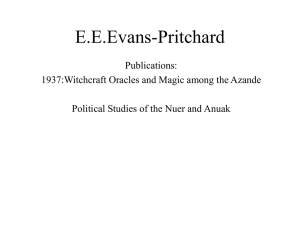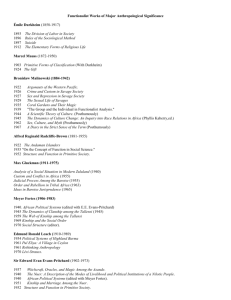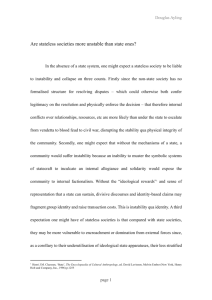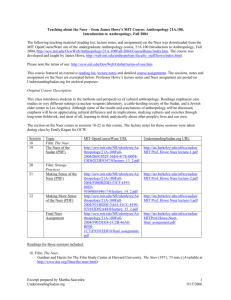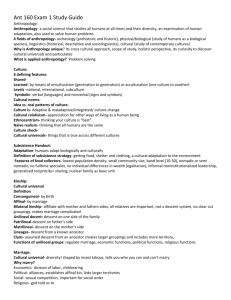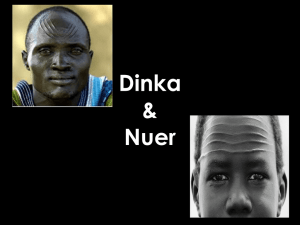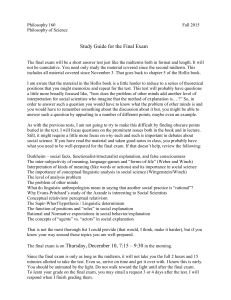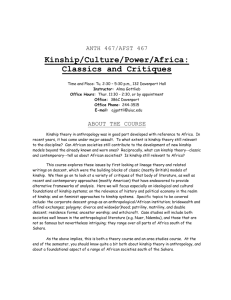read PDF version - Pitt Rivers Museum
advertisement
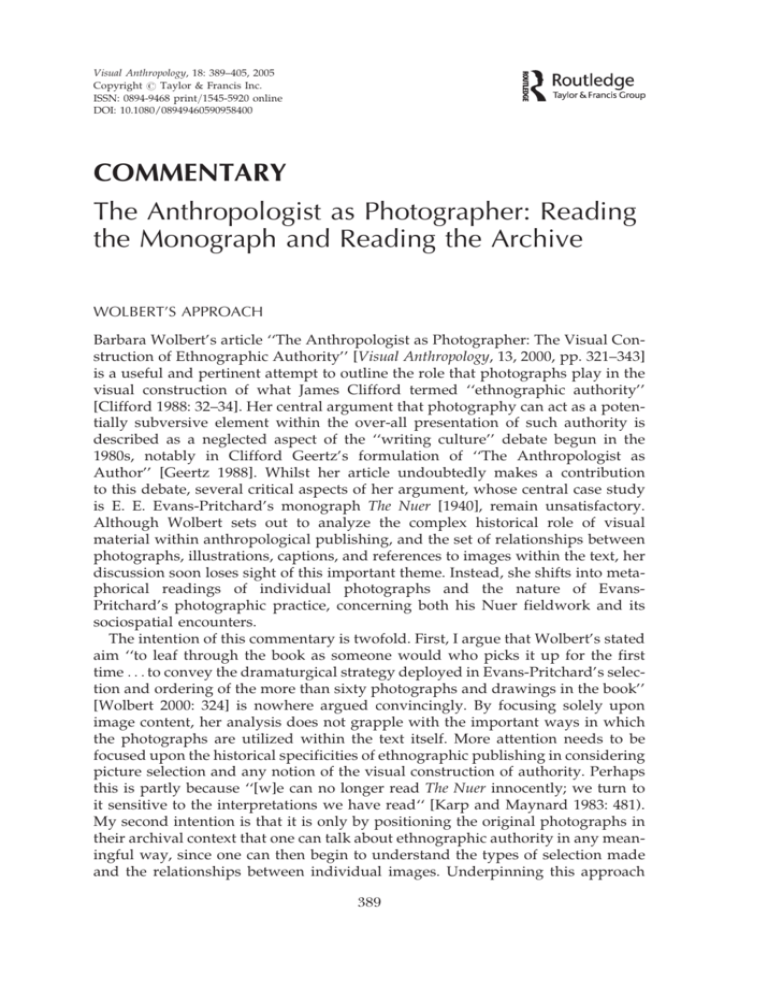
Visual Anthropology, 18: 389–405, 2005 Copyright # Taylor & Francis Inc. ISSN: 0894-9468 print=1545-5920 online DOI: 10.1080/08949460590958400 COMMENTARY The Anthropologist as Photographer: Reading the Monograph and Reading the Archive WOLBERT’S APPROACH Barbara Wolbert’s article ‘‘The Anthropologist as Photographer: The Visual Construction of Ethnographic Authority’’ [Visual Anthropology, 13, 2000, pp. 321–343] is a useful and pertinent attempt to outline the role that photographs play in the visual construction of what James Clifford termed ‘‘ethnographic authority’’ [Clifford 1988: 32–34]. Her central argument that photography can act as a potentially subversive element within the over-all presentation of such authority is described as a neglected aspect of the ‘‘writing culture’’ debate begun in the 1980s, notably in Clifford Geertz’s formulation of ‘‘The Anthropologist as Author’’ [Geertz 1988]. Whilst her article undoubtedly makes a contribution to this debate, several critical aspects of her argument, whose central case study is E. E. Evans-Pritchard’s monograph The Nuer [1940], remain unsatisfactory. Although Wolbert sets out to analyze the complex historical role of visual material within anthropological publishing, and the set of relationships between photographs, illustrations, captions, and references to images within the text, her discussion soon loses sight of this important theme. Instead, she shifts into metaphorical readings of individual photographs and the nature of EvansPritchard’s photographic practice, concerning both his Nuer fieldwork and its sociospatial encounters. The intention of this commentary is twofold. First, I argue that Wolbert’s stated aim ‘‘to leaf through the book as someone would who picks it up for the first time . . . to convey the dramaturgical strategy deployed in Evans-Pritchard’s selection and ordering of the more than sixty photographs and drawings in the book’’ [Wolbert 2000: 324] is nowhere argued convincingly. By focusing solely upon image content, her analysis does not grapple with the important ways in which the photographs are utilized within the text itself. More attention needs to be focused upon the historical specificities of ethnographic publishing in considering picture selection and any notion of the visual construction of authority. Perhaps this is partly because ‘‘[w]e can no longer read The Nuer innocently; we turn to it sensitive to the interpretations we have read‘‘ [Karp and Maynard 1983: 481). My second intention is that it is only by positioning the original photographs in their archival context that one can talk about ethnographic authority in any meaningful way, since one can then begin to understand the types of selection made and the relationships between individual images. Underpinning this approach 389 390 C. Morton is the notion that the image has a biography—that its original inscription in the negative is only a starting point for a complex series of related objects through time and space.1 An awareness of the biographical relations between photographic objects has become one of the key research areas in current museological practice. Staff at the University of Oxford’s Pitt Rivers Museum continue to work to make its collections, including Evans-Pritchard’s field photographs, accessible online to overseas scholars in order to improve and widen their research potential. As a research officer on an Arts and Humanities Research Board-funded project relating to the Museum’s southern Sudanese collections,2 much of my time has been spent researching Evans-Pritchard’s field photographs. The intention of this project is to produce a fully researched web resource of the Museum’s extensive object and photographic collections from the region, collections that might shed new historical light on a group of societies much-studied in the anthropological literature. Arguably, it is only through such a deeply engaged perspective with the data that one can begin to make worthwhile theoretical observations. Wolbert introduces her article with an outline of how discussions since the 1980s concerning the nature of authority in ethnographic writing have neglected the role that photographs play in such literature. She then gives a brief overview of the recent literature on photography and anthropology, arguing that the field photography of anthropologists since circa 1930 has been a neglected area. This is far too thin a gloss, however, neglecting reference to Étienne Samain [1995] or Michael Young’s [1998] analysis of Malinowski’s photography and Ira Jacknis’s [1984] work on Margaret Mead and Gregory Bateson. Neither does she mention John Hutnyk’s [1990] discussion of Evans-Pritchard’s photographs in The Nuer, which he also analyzes in the light of the ‘‘writing culture’’ debate. Whilst Wolbert does deal with Geertz’s brief discussion of Evans-Pritchard’s published photographs [Wolbert 2000: 331, Geertz 1988: 66], she does not engage with his interesting conclusion concerning Evans-Pritchard’s authorial technique, that is, ‘‘his enormous capacity to construct visualizable representations of cultural phenomena—anthropological transparencies’’ [Geertz 1988: 64]. Geertz’s suggestion of a link between the visualizable as a dimension of ethnographic writing and the visual presentation of photographs within The Nuer is an important interplay worthy of fuller treatment. In the next section she moves on to discuss her central case study, EvansPritchard’s 1940 monograph, a book cited by James Clifford as an example of the literary construction of ‘‘ethnographic authority’’ [Clifford 1988: 32–34]. Extending this notion, Wolbert argues that analysis of the photographs reproduced in The Nuer shows a parallel process of the ‘‘visual construction’’ of such authority, acting to ‘‘draw the viewer in and position the author as interpreter,’’ through a ‘‘dramaturgical strategy’’ [Wolbert 2000: 324] of image ordering and disclosure. In the next section, she reproduces a number of page-spreads from the monograph to make explicit the way in which visual material is used by Evans-Pritchard to generate the centrality of the bovine idiom that lies at the heart of Nuer experience, as well as the authoritative presence of the author within this world. In the next major section of the article, Wolbert argues that The Anthropologist as Photographer 391 not only has the role of photography within ethnographies been a neglected aspect of the ‘‘writing culture’’ debate, but that the topic is also a ‘‘blind spot’’ [Wolbert 2000: 331] of the discipline of visual anthropology, with perhaps the exception of Kirsten Hastrup [1993] whom she discusses at some length. A description of the nature of visual literacy then follows, in preparation for the next section, a detailed visual reading of three photographs from The Nuer. The argument is presented that ‘‘the disruptive nature of photography in the ethnographic context is based upon the independence of photography from picture arrangement’’ [Wolbert 2000: 333], that is, that the image is infinitely recodable. In the discussion that follows, Wolbert strays from analysis of the published monograph and attempts to draw a number of conclusions about Evans-Pritchard’s photographic output and fieldwork encounters. It is this final and critical section, in which Wolbert attempts to demonstrate the subversive nature of photography, that is particularly problematic. It is one thing to argue for the subversive potential of published images, it is another to make suppositions about ‘‘the legibility of a photograph’’ involving such things as ‘‘a slipping of the co-ordinates in the chosen set segment’’ [Wolbert 2000: 333], when analysis of the original photographs (as opposed to the reproduced images) does not support such readings. READING THE MONOGRAPH Importantly, the ethnographic monograph is often not one book but many, since reprints, revisions and changes in format over time (such as paperback publication) are all essentially new productions involving new sets of editorial procedures and financial considerations (such as sales, costs, etc.). Although all of Wolbert’s references and reproductions in her article are from the first edition of The Nuer [1940], her bibliographic reference is to the 1969 first American paperback printing, presumably the only copy readily available. Whilst in the 1969 paperback edition the text pagination of the first edition is retained since it is produced from the original sheets, the photographs are printed double-sided on plain paper and not spaced throughout the book in the same way. In fact, difficulties in obtaining the original photographic blocks meant that Oxford University Press’s New York division decided to photograph the images from the first edition itself.3 Without the first edition (with its different picture arrangement) to hand, how can the aim to ‘‘leaf through the book as someone would who picks it up for the first time’’ [2000: 324] be a credible one? Subsequent changes to picture arrangement are important aspects of the ‘‘dramaturgical strategy’’ that Wolbert is attempting to demonstrate, since it affects when the reader encounters certain images while reading the text. In the case of one image that I discuss in detail later, that of ‘‘Milking a restless cow’’ (Plate III), in the 1969 printing it no longer faces the description of milking [Evans-Pritchard 1940: 22] that it was intended to illustrate, but instead is encountered by the reader several pages earlier. In the 1977 reprinting of Evans-Pritchard’s other influential work, Witchcraft, Oracles and Magic among the Azande [1937b], all the (now poorer quality) plates are printed double-sided and repositioned at the back of the book, instead of 392 C. Morton throughout the text as in the first edition and reprintings up to 1972. Does this change represent a shift in ‘‘dramaturgical strategy’’ by forcing us to do some work by flipping to the back of the book as we come across image references within the text? Certainly not on the part of Evans-Pritchard himself, who died in 1973. The change seems to have been brought about by a move to a different printer in Northamptonshire. To see Evans-Pritchard as the ‘‘author of a picture story’’ [Wolbert 2000: 333] is far too simplistic when we consider the historical contexts and constraints within which the pictures were selected and arranged for publication—contexts that problematize the notion that the published images represent a straightforward visual statement of ethnographic authority. In the Wolbert article’s final section, ‘‘Anthropological Transparencies,’’ she makes the important point that not all of the photographs published in The Nuer were taken by Evans-Pritchard. In fact, six other sources are acknowledged, one of which (Plate IX) is almost certainly not even of Nuer but Shilluk [Johnson 1979]. Wolbert’s argument is that Evans-Pritchard ‘published a certain kind of photo from other sources than his own large photo collection’ [Wolbert 2000: 333]—essentially close up portraits—as opposed to his own images that were more distant. Oddly, however, one of the three examples that Wolbert presents of such other sources [Wolbert 2000: 333], that of Plate XXIX ‘Man (Nasser Post),’ was in fact taken by Evans-Pritchard himself, as is indicated in the List of Plates. Perhaps a more important point about the use of plates in The Nuer is the fact that eight of them were made from printing blocks made up for previous articles in Sudan Notes and Records4 and elsewhere (such as in Seligman [1932]), a fact also made clear in the List of Plates. One of the images that Wolbert discusses (Plate VIII, ‘‘Sandy ridge with cattle byres on the horizon’’) is an excellent case in point. This same image was originally published in the first of a two-part article in Sudan Notes and Records in 1937 with the caption ‘‘Sandy ridge with homesteads in the background (Duk Country).’’ The publisher’s block was then reused by Oxford University Press for The Nuer some three years later. Analysis of the original negative [referred to later in this commentary as Figure 8] shows that the published image has been cropped markedly on the right by the original publisher (who has also marked the original negative), a manipulation which has then been reproduced through the use of the same block in The Nuer. The biographical movement from photograph to published image reveals the important fractures between the photographer’s frame and subsequently imposed frames, which reproduce a dramatically altered reading of the original photograph. In the case of the sandy ridge photograph, the standing figure was framed centrally by Evans-Pritchard, showing that the youth was ostensibly the subject of one of his many physical ‘‘type’’ photographs. Further evidence that the seated youth was not an intended subject is provided by further close-up portraits of the central youth. By cropping the space to the right, the publisher of Sudan Notes and Records attempts to rebalance the image and to change the marginal status of the seated youth by reemphasising the relationship between the two figures, a probably unintended dimension of the original photograph. Although this biographical context is left unexplored by Wolbert, the interplay of contexts, intentions, and meanings between the original photograph and the published image is surely of central importance here, since the assumption that the published image The Anthropologist as Photographer 393 ‘‘is’’ the photograph ignores in an essential way the critical interventions of the publishing process. More than this, the fact that blocks made for previous publications were reused in The Nuer further problematizes the notion of a straightforward presentation of ethnographic authority, since it suggests a level of serendipity, or at least expediency, in picture selection. There is even the possibility that Evans-Pritchard’s decision to reuse previously published images within The Nuer was due to the increased cost of producing new blocks from original negatives at the onset of war.5 As the detailed publication history of EvansPritchard’s images shows [see note 4], some of the previously made blocks were kept together as plates in The Nuer, and some mixed to form new plates, which suggests both a continuity of visual narrative from previous articles as well as an attempt to reorder and rethink the visual presentation within the larger monograph. This approach to illustration mirrors Evans-Pritchard’s view of his books as the bringing together of previously published articles in a new form. Criticizing Geertz’s claim that images within The Nuer are ‘‘unreferred to’’ [Geertz 1988: 66], Wolbert makes the point that Evans-Pritchard constantly refers to them throughout the book. This is an important aspect of the relationship between textual and visual authority that Wolbert fails to expand on—important because textual references to the plates can be considered extended captions that operate to both narrow and open out the potential range of meanings within the image. This is an important point, since some commentators [e.g., Hutnyk 1990: 90] have held up the brevity of the captions, such as ‘‘Youth’’ or ‘‘Girl milking,’’ as exemplifying some form of distanced essentialism. A good example of the type of textual reference that Evans-Pritchard makes to images within the book is the following: ‘‘I ask the reader to look at some of the illustrations, for example the Frontispiece and Plates III, V, and XVII, which will convey to him better than I can do in words the crudity of kraal life’’ [Evans-Pritchard 1940: 40]. This sort of comment, found throughout the book, is highly revealing in a number of ways. First, it establishes a break in the flow of ethnographic prose that surrounds it, an intervention that asks the reader to become active in seeking out the plates referred to and drawing parallels between the separate images. In particular, Evans-Pritchard is asking both the reader and the images to corroborate his preceding statement that ‘‘the stark nakedness of Nuer amid their cattle and the intimacy of their contact with them present a classic picture of savagery’’ [Evans-Pritchard 1940: 40]. There is no doubt that these often detailed textual references to the plates act as extended captions, and seek to place the readings of the images within the overall argument that Evans-Pritchard is attempting to build. Such extended captioning of the images throughout the text in part explains the brevity of the plate captions, which merely serve to summarize, in conventional publishing format, the image content. My argument is that far too much analytical weight has been placed on the relationship between image and caption in The Nuer, without fully taking into account Evans-Pritchard’s complex strategic usage of them, from the text outwards. Evans-Pritchard’s numerous references to the plates also suggest a dynamic interplay between picture selection and the writing process. Often the references have been seemingly inserted into the flow of a previously written block of text, such as with ‘‘how terrific are these rains may be judged from Plate XIV’’ 394 C. Morton [Evans-Pritchard 1940: 64]; and frequently the same image will be referred to at different places if it serves to illustrate some different subject matter or item of material culture. Such evidence strongly suggests that Evans-Pritchard had the final picture selection organized at an early stage of writing the book. Such frequent cross-referencing of plates also suggests that the photographs that he had selected were laid out for reference during the writing process. A good example of this is his description of the scars left by Nuer initiation or gar, stating that ‘‘they are particularly clear in Plates XXVI(b), XXVII, and XXVIII’’ [Evans-Pritchard 1940: 249]. His use of images within The Nuer is thereby highly illustrational, but the complex framework of textual references makes it clear that he saw the photographs as providing multiple points of entry from differing ethnographic contexts. READING THE ARCHIVE I have so far argued for the analytical separation of the published image from the photograph as an archival object, and have thus far attempted to raise various issues and research questions concerning the historical contexts of photographic Figure 1 ‘‘Milking a restless cow (Lou),’’ with a man bracing the cow’s rear legs. Published as Plate III in The Nuer. Photographed by E.E. Evans-Pritchard in 1935 at Yakwach village on the Sobat River. The negative is shown whole to include Evans-Pritchard’s film number annotation written on the reverse side. Scan from original negative. Image dimension: 84 57 mm. [PRM 1998.355.68.1] The Anthropologist as Photographer 395 reproduction in books such as The Nuer. I now want to move on to show how an archival understanding of the published images that Wolbert analyzes is an essential part of any notion of the visual construction of ethnographic authority. The first photograph from The Nuer that Wolbert analyses in detail is Plate III, entitled ‘‘Milking a restless cow (Lou)’’ [Figure 1], pointing out the following: This laconic comment [‘Milking a restless cow’] gives us a little story which we attempt to verify through the picture. Not only is a man with his back to the camera milking in the foreground, but more milking is going on in the background. The young man is standing there casually, holding the line with which the cow’s rear legs are tethered. Either the cow cannot be that restless, or the man must be able to register the cow’s slightest movement. . . he seems completely absorbed by what the person to his right is saying or doing . . . it might well be another man milking. [Wolbert 2000: 325] The image referred to is reproduced in her article as a full-page spread from The Nuer [Wolbert 2000: 326], and also subsequently above the Frontispiece image from the book [Wolbert 2000: 336], the significance of which I shall make clear. In both instances Wolbert has reproduced the image of the ‘‘casual’’ man back-tofront, with the man to the right of frame instead of the left. The significance of Figure 2 ‘‘Section of homestead and kraal (Eastern Gaajok)’’ published as the Frontispiece to The Nuer. This is in fact an image of a Lou man at Yakwach village on the Sobat River, holding the tethering rope of the ‘‘restless cow.’’ E.E. Evans-Pritchard, 1935. Scan from original negative. Image dimension: 84 57 mm. [PRM 1998.355.131.1] 396 C. Morton this error may seem trivial until one considers its relationship to the Frontispiece image [Figure 2], incidentally reproduced by Wolbert without its caption, ‘‘Section of homestead and kraal (Eastern Gaajok).’’ Although these two images were captioned by Evans-Pritchard as having been taken among differing although neighboring Nuer tribes, the Lou and the Gaajok, their original film numbers, clearly written on the reverse of both the negative and the original working print, indicate that not only do they belong to the same film, but that they are probably sequential exposures. According to these film numbers he first took the Frontispiece image (64 A183) and then the image of the ‘‘casual’’ man (64 A184). The evidence of the documentation is confirmed when the two images are placed side by side, with the Frontispiece here enlarged slightly to form a composite [Figure 3], showing that not only were they taken in the same location rather than separate ones, but that they were taken immediately after one another, with the camera turned a few degrees. With this new composite image there are now two men restraining the cow, which is also tethered to the ground, its calf being held back from suckling by an unseen figure to the right of the frame. These two men are joined by a third man, all three of them watching something happening beyond the frame to the left, probably a youth performing a praise-song about a favorite ox, rather than ‘‘another man milking’’ as Wolbert suggests. Some evidence for this is found in another photograph from the archive (original negative number 64 A182) [Figure 4] in which we see the milking Figure 3 Composite arrangement of Plate III and the Frontispiece to The Nuer, the latter enlarged slightly to enhance the spatial relationship between the two. [PRM 1998.355.68.1 & PRM 1998.355.131.1] The Anthropologist as Photographer 397 Figure 4 A photograph taken prior to both Plate III and the Frontispiece at Yakwach, showing youths holding the attention of the man holding the ‘‘restless cow.’’ The shadow of one of these youths with arms raised above his head in a praise attitude, can be seen in the Frontispiece image. E.E. Evans-Pritchard, 1935. Scan from original negative. Image dimension: 84 57 mm. [PRM EP.N.XIV.47] activity from further back, with two youths to the left of the frame, one of whom is wearing metal arm-rings (known as thiau). As Evans-Pritchard moves forward to take the next photograph in the sequence [Figure 2], a shadow, probably from the youth wearing arm-rings, can be seen cast across the ground in front of the man, near the cow’s tethering peg—a shadow with arms raised in imitation of the trained horns of a favorite ox.6 This is the characteristic gesture made by Nuer youths during the recitation of a praise-song about a favorite ox or merely the calling out of their ox-name which they gain after initiation. Although in the next photograph in the sequence [Figure 1], this shadow is no longer evident, the blurred hand of the gesturing youth can be made out intruding into the frame on the left. Within the milking activity that is ostensibly the subject of these images, Wolbert sees a ‘‘man with his back to the camera milking a cow’’ [Wolbert 2000: 325]; this may seem surprising after one has read Evans-Pritchard’s statement on the facing page that ‘‘men are forbidden to milk cows’’ [Evans-Pritchard 1940: 22]. Wolbert’s footnote arguing that ‘‘in camps milking is performed by men’’ [Wolbert 2000: 339] is certainly not stated by Evans-Pritchard on the page she cites [Evans-Pritchard 1940: 22], and I have not found reference elsewhere. This is almost certainly a woman milking, not least since another woman and a young girl or boy (milking a cow in the background) can also be seen in the 398 C. Morton images, but also due to her build, hairstyle and scarification design on the back. Evans-Pritchard’s own textual reference to the image on the facing page is that ‘‘the milker squats by the cow and milks a single teat at a time into the narrow mouth of a bottle-necked gourd balanced on her thighs (see Plates III and V) . . . if a cow is restless a man may hold it still . . .’’ [Evans-Pritchard 1940: 22, emphases added]. Part of the ‘‘casual’’ manner of the man (incidentally described by Geertz as ‘‘a tall, naked cowherd leaning, negligently, legs crossed, against the tension of a tether’’ [Geertz 1988: 66]) is surely his unease at being indirectly involved in the ritually dangerous activity of milking. Evans-Pritchard elsewhere wrote that Tot, one of his servants, had died in 1936 and that ‘‘the reason given for his death was that after initiation he had milked a cow secretly at night in a byre and drunk its milk’’ [Evans-Pritchard 1938: 217]. This prohibition was also noted by the District Commissioner Percy Coriat in 1923.7 Although this sort of detailed analysis seems, on the face of it, to go beyond the argument Wolbert attempts to build, it shows that the archive as a visual totality can allow us to move beyond the framed boundaries of the individual photographs towards a more relational understanding. In the case of Evans-Pritchard’s collection, the photographs are relational in several senses. On one level they are part of a series of negatives (a film or set of related films) that links them together temporally and through subject-matter, and on another level they are related through their subsequent archival situations, selections, and groupings. Both sets of relational possibilities are important aspects of the biography of the photographic object, encompassing both its inception and subsequent usage. Such an archival interrogation of the collection can also undermine the authority of the photographer. Aside from Evans-Pritchard’s Frontispiece there are other instances where Evans-Pritchard was confused about the precise location of his photographs, his shorter fieldwork trips of 1935 and 1936 being especially ripe for confusion. The next photograph Wolbert discusses in detail is Plate XXIX from The Nuer, ‘‘Man (Nasser Post)’’ [see Figure 7]. Wolbert comments: . . . we see a man with two spears and an item that may be a quiver. He goes along a path cut by automobile tires. The man is walking beside the path, presumably to get out of the way of a vehicle. Someone is coming, or—more likely, if one considers the direction of the blur of the man’s feet and the angle of the two spears and the quiver he is carrying—someone is driving away. This reading of the photograph can be presumed not only on the basis of photo-technical observation of the blur and knowledge of movement, but also due to the composition, dominated by a movement corresponding to the Western world’s main direction of reading from upper left to lower right. This increases the impression that the photographer has turned around again to look at the place he is leaving. The man in the picture is watching the other being driven away. The composition of the picture, determined by the verticality of man and path, the row of trees on the horizon, and the spears and pipe in the foreground, conveys the image of a barrier closing behind the brave researcher who had raised it for a while. The viewer leaves the by now more familiar, foreign region at the author’s side. [Wolbert 2000: 330] In the context of Wolbert’s argument, we could reasonably expect an analysis of this image to confine itself to its operation in the visual construction of authority The Anthropologist as Photographer 399 Figure 5 Looking down a path at Nasir towards a spear-carrying Nuer man walking away, with another man wearing a body cloth and smoking a pipe looking back towards the camera. E.E. EvansPritchard, 1935. Scan from original negative. Image dimension: 84 57 mm. (Original number 28 4 A232) [PRM EP.N.XVI.55] from a viewer’s perspective, or indeed, as she also argues, how it works to subvert such authority. However, none of the readings she puts forward about this image seem valid from this perspective. Is this really a track cut by tires? If so, where are the tire tread marks in the sand? Is the photographer really in the back of a vehicle being driven away? If so, how does he manage not to blur the image and where is the dust thrown up by the wheels? Are the man’s spears really like ‘‘a barrier closing behind the brave researcher who had raised it for a while’’? To answer these questions, we can go back to the archive, which shows that Evans-Pritchard took three photographs of this man on the path in quick succession.8 In the first image taken [Figure 5] we see that the man (who is, incidentally, carrying a ghur or ambatch (Aeschynomene elaphroxylon) parrying shield, and not a quiver or pipe9) is walking not on an automobile track but on a single path edged with stones near the Sobat River at Nasir. Evans-Pritchard is not in the back of a vehicle being driven away but is following the man on foot, with another man smoking a pipe looking back at him. In the second image [Figure 6] Evans-Pritchard has moved off the path to the left, probably to stand beside the man smoking the pipe, and takes another shot of the spear-carrier who has turned to them. In the third (published) image [Figure 7], we now see that Evans-Pritchard has moved forwards and to his right, approaching the spear carrier. Perhaps some words were exchanged 400 C. Morton Figure 6 The spear-carrying Nuer man on a path at Nasir, taken from off the path to the left. E.E. Evans-Pritchard, 1935. Scan from original negative. Image dimension: 84 57 mm. (Original number 28 4 A234) [PRM 1998.355.7.1] (he spoke Nuer well by 1935 when this image was probably taken), and he then raised the camera to take another shot. The man has also moved off the path to the right, probably during their short verbal exchange between shots, and now turns to leave (or lead the way?) down the path as the photograph is being taken. With this new archival interpretation, the visual metaphors of leaving and of barriers closing behind both author and viewer are seen to be erroneous. If anything, the sequence suggests metaphors of approaching and entering the Nuer world. This would not be necessarily problematic if the argument had been made by Wolbert that whatever else the archive may suggest, the published image alone suggests the metaphor of ‘‘leaving’’ to the reader. Instead, the analysis is presented with the pseudo-scientific authority of ‘‘photo-technical observation . . . corresponding to the Western world’s main direction of reading’’ [Wolbert 2000: 330]. Finally, Wolbert makes a number of comments about Evans-Pritchard as a photographer and his overall photographic output that I hope to address more fully in other publications. Some of them may be briefly responded to here, however. The first is the assumption that ‘‘the formats of the printed pictures vary although the negatives from Evans-Pritchard’s Nuer research are all 6 6 cm’’ [Wolbert 2000: 333]. This is incorrect, there being five main negative formats, three used during 1930–1931 and two (the 6 6 cm format for a Rolleiflex and a 3- 14 2- 14 inch format for a Kodak) used during the 1935–1936 fieldwork. The Anthropologist as Photographer 401 Figure 7 The spear-carrying Nuer man turning to move off down the path at Nasir, taken from a third camera position on the path. Published as Plate XXIX in The Nuer. This is the most proximal portrait of the man in the sequence, and shows an attempt by Evans-Pritchard to get a decent physical type image during a verbal exchange. E.E. Evans-Pritchard, 1935. Scan from original negative. Image dimension: 84 57 mm. (Original number 28 4 A235) [PRM 1998.355.100.1] Figure 8 ‘‘Sandy ridge with cattle byres on the horizon (Dok),’’ Nuer Dok youths at Ler in western Nuerland, 1936. Scan of original negative, which has been marked with a pencil crop line towards the right, almost certainly by its first publisher at Sudan Notes and Records in 1937. Published as Plate VIII in The Nuer. Image dimension: 58 55 mm. [PRM 1998.346.341.1] 402 C. Morton Wolbert’s assertion that the two photographs of the men holding the restless cow ‘‘were taken in secret, by the camera which happened to be hanging around Evans-Pritchand’s neck’’ [Wolbert 2000: 334], i.e., Rolleiflex images, is wrong since the negatives themselves are the larger 3- 14 2- 14 inch size (for a Kodak). Again, a brief visit to the archive itself would have confirmed this.10 She is right to point out that in many of the images taken with his Rolleiflex camera, the gaze of the subject is usually not into the camera but either just above it at the level of the photographer’s head, or often elsewhere. But from a historical perspective, the important point is not that the Rolleiflex images ‘‘trick’’ us into reading a ‘‘lack of proximity into ethnographic authority’’ [Wolbert 2000: 337], but that Evans-Pritchard’s two distinct phases of Nuer fieldwork (1930–31 and 1935–36) were carried out in different political and social contexts in the region, and that this is inscribed within the images. Whereas the political situation in 1930 meant that he ‘‘abstained from photographing a single cow’’ [Evans-Pritchard 1937a: 242], his return to eastern Nuerland in 1935 led to a frenzy of photographically recording cattle and milking techniques, including the use of a tulchan. This photographic practice was brought about by a transformed set of relations to the Nuer in his later fieldwork. In 1935 he spent a month at the home of his cook, Tiop, who had earlier worked for him in 1931, and whose community at Mancom made him ‘‘welcome on his account’’ [Evans-Pritchard 1990: 106]. In 1936 he spent five out of seven weeks in the home village of Nhial, a youth who had worked for him in both 1930 and 1931, and whose community considered him a ‘‘friend of the family’’ [Evans-Pritchard 1974: 35]. Far from lacking proximity, these later images are often striking in their relaxed immediacy, with extended sequences of dance and religious rites a particular feature. Knowledge of these sequences and relationships has only been reconnected within the archive through detailed research of individual images across the collection, and demonstrates just what can be done when analysis moves beyond the confines of the published image, to a more nuanced history of the inscription and subsequent biography of the photograph. What I have tried to address in this comment is that there is a tendency in some theoretical writing on photography to elide the distinction between the published image and the photograph as a cultural object. Wolbert’s approach in my opinion suffers from a dangerous slippage from the analysis of a book and its images into an analysis of photographs and of a photographer. The conflation of these two categories with related but essentially separable trajectories means that object-led archival research is often replaced with image-led ‘‘photo-technical observation,’’ with the inevitable misreadings that follow. NOTES 1. An early development of the biographical approach to material culture was Igor Kopytoff’s [1986] contribution to Appadurai’s influential edited volume. Recent work that highlights the biographical dimensions of photographs as cultural objects can be found in Edwards [2001] and Edwards and Hart [2004a and 2004b]. 2. ‘‘Recovering the Material and Visual Cultures of the Southern Sudan: A Museological Resource’’ is a two-year project (2003–2005) funded by a grant to Jeremy Coote and The Anthropologist as Photographer 3. 4. 5. 6. 7. 8. 9. 10. 403 Elizabeth Edwards of the Pitt Rivers Museum, University of Oxford, from the Resource Enhancement Scheme of the Arts and Humanities Research Board (grant number: B=RE=AN4817=APN15467). The support of the AHRB is gratefully acknowledged here. Letter dated 15.5.1969 from Oxford University Press, New York Office, to Head Office, Oxford, on the subject of the first paperback edition of The Nuer [Oxford University Press Archive ref: PB=ED=001071 OP214]. Plate VIIa (facing page 62) in The Nuer was first published as Plate VIb (facing page 224) in Sudan Notes and Records, 20(3), 1937a. Plate VIIb (facing page 62) was first published as Plate VIIa (facing page 232) in Sudan Notes and Records, 20(3), 1937a. Plate VIII (facing page 68) was first published as Plate V (facing page 216) in SNR, 20(3), 1937a. Plate XVa & b (facing page 134) was first published as Plate IIIa & b (facing page 74) in SNR, 17(1), 1935. Plate XXIa (facing page 200) was first published as Plate VIa (facing page 224) in SNR, 18(3), 1937a. Plate XXIb (facing page 200) was first published as Plate VIIb (facing page 232) in SNR, 18(3), 1937a. Plate XXVIa & b (facing page 236) was published with the youth with ash-covered hair to the right, as Plate II (facing page 42) in SNR 18(1), 1935. These two images are credited to the District Commissioner F. D. Corfield in The Nuer, but not in SNR. Plates XXV and XXVIII in The Nuer (five images) are taken from blocks made for C.G. and B.Z. Seligman [1932]. As with the blocks from SNR, some of these blocks were subsequently kept together to form plates in The Nuer, although the picture editor at Oxford University Press swapped several of them around to form new plates and thereby a new visual narrative. Other noted sources in The Nuer are the Royal Air Force; the American Presbyterian Mission at Nasir (probably Blanche Cora Soule); Yuzbashi (i.e., Captain) Talib Ismail, a Sudanese officer who served in Upper Nile Province as a sub-mamur at Akobo 1920–1927; E. S. Crispin (medical officer in Sudan from 1904); Frederick L. Hamer, Assistant and District Commissioner for Eastern Nuerland 1932–1936; Frank D. Corfield, District Commissioner in Nasir District of Upper Nile Province 1931–1935. In a letter (unsigned) from Oxford University Press to Evans-Pritchard, dated 11th June 1945, the writer argues that book production charges had risen 50 percent over prewar levels, and that illustrations for his proposed book on the Sanusi would have to be modest [Oxford University Press Archive ref: PB=ED=001071 OP214]. A photograph of this type of gesture can be seen in another of Evans-Pritchard’s books [Evans-Pritchard 1990, Plate VII] entitled ‘‘A youth singing in praise of his ox. His arms are raised in imitation of its horns.’’ ‘‘An adult Gaweir may not milk cattle or grind corn. It is said that a man who milks his own cow will die. . .’’ [Johnson 1993: 33]. Figure 5 has the original film number [28=4 A232], Figure 6 [28=4 A234], and Figure 7 [28=4 A235], all annotated by Evans-Pritchard on the negative and contact print reverse. The ambatch-wood parrying shield the man is carrying is referred to explicitly on page 86 of The Nuer. An illustration of this type of object is reproduced in EvansPritchard’s Nuer Religion [1974 (1956): 251], captioned ‘‘Fig. 5 Hollowed-out ambatch log, used as stool, &c.’’ It was drawn by Louis Clarke from the shield that E-P collected in 1936 among the western Nuer and donated to the Pitt Rivers Museum in 1937 [PRM 1937.34.44]. The Museum accession volume includes the description: ‘‘Ghur, short parrying-shield of ambatch, with pockets for tobacco & trifles.‘‘ In a footnote, Wolbert acknowledges correspondence in 1996 from Elizabeth Edwards, Head of Photograph Collections at the Pitt Rivers Museum, as her source for technical information on the Evans-Pritchard archive. The Museum however always issues such correspondence with the caveat that such brief information cannot be reproduced in 404 C. Morton any authoritative manner given the partial nature of research on most collections. Such a caveat inevitably applied to the Evans-Pritchard collection, which had never been fully catalogued before the current project began in 2003. REFERENCES Clifford, James 1988 The Predicament of Culture. Twentieth Century Ethnography, Literature and Art. Cambridge, Mass., and London: Harvard University Press. Edwards, Elizabeth 2001 Material Beings: Objecthood and Ethnographic Photographs. Visual Studies, 12(1): 67–75. Edwards, Elizabeth, and Janice Hart 2004a Introduction. In Photographs Objects Histories. On the Materiality of Images. Elizabeth Edwards and Janice Hart, eds. Pp. 1–15. London and New York: Routledge. 2004b Mixed Box: The Cultural Biography of a Box of ‘Ethnographic Photographs.’ In Photographs Objects Histories. On the Materiality of Images. Elizabeth Edwards and Janice Hart, eds. Pp. 47–61. London and New York: Routledge. Evans-Pritchard, Edward E. 1935 The Nuer: Tribe and Clan. Sudan Notes and Records, 18(1): 37–87. 1937a The Economic Life of the Nuer: Cattle (Part 1). Sudan Notes and Records, 20(3): 210–245. 1937b Witchcraft, Oracles and Magic Among the Azande. Oxford: Clarendon Press. 1938 The Economic Life of the Nuer: Cattle (Part 2). Sudan Notes and Records, 21(1): 32–77. 1940 The Nuer. A Description of the Modes of Livelihood and Political Institutions of a Nilotic People. Oxford: Clarendon Press. (1968 printing by Oxford University Press. Lithographic reproduction from original sheets.) 1969 The Nuer. A Description of the Modes of Livelihood and Political Institutions of a Nilotic People. New York: Oxford University Press. (Eighth printing [1976] of first American paperback edition.) 1974 Nuer Religion. New York and Oxford: Oxford University Press; (original 1956). 1990 Kinship and Marriage Among the Nuer. Oxford: Clarendon Press; (original 1951). Geertz, Clifford 1988 Works and Lives: The Anthropologist as Author. Cambridge: Polity Press. Hastrup, Kirsten 1993 Anthropological Visions: Some Notes on Visual and Textual Authority. In Film as Ethnography. Peter Ian Crawford, and David Turton, eds. Pp. 8–25. Manchester and New York: Manchester University Press. Hutnyk, John 1990 Comparative Anthropology and Evans-Pritchard’s Nuer Photography. Critique of Anthropology, 10(1): 81–82. The Anthropologist as Photographer 405 Jacknis, Ira 1984 Margaret Mead and Gregory Bateson in Bali: Their Use of Photography and Film. Cultural Anthropology, 3(2): 160–177. Johnson, Douglas, ed. 1979 Nuer or Shilluk? Man, 14(1): 165. 1993 Governing the Nuer. Documents by Percy Coriat on Nuer History and Ethnography, 1922–1931. Oxford: JASO Occasional Papers, No. 9. Karp, Ivan, and Kent Maynard 1983 Reading the Nuer. Current Anthropology, 24(4): 481–503. Kopytoff, Igor 1986 The Cultural Biography of Things: Commoditization as Process. In The Social Life of Things: Commodities in Cultural Perspective. A. Appadurai, ed. Pp. 64–91. Cambridge: Cambridge University Press. Samain, Étienne 1995 Bronislaw Malinowski et la photographie anthropologique. L’Ethnographie, 91(2): 107–130. Seligman, C. G., and B. Z. Seligman 1932 Pagan Tribes of the Nilotic Sudan. London: Routledge and Kegan Paul. Young, Michael W. 1998 Malinowski’s Kiriwina: Fieldwork Photography 1915–1918. Chicago and London: University of Chicago Press. Wolbert, Barbara 2000 The Anthropologist as Photographer: The Visual Construction of Ethnographic Authority. Visual Anthropology, 13: 321–343. Christopher Morton Pitt Rivers Museum Oxford, U.K. christopher.morton@pitt-rivers-museum.ox.ac.uk
